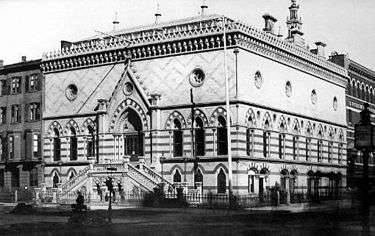Peter Bonnett Wight
Peter B. Wight (1838–1925) was a 19th-century architect from New York City who worked there and in Chicago.
Biography
Wight's career "flourished in the 1860s and 1870s in New York, where he developed a decorative, historicist style that showed affinities to the work of European designers John Ruskin and Augustus Welby Northmore Pugin." After the Chicago fire of 1871, Wight came to Chicago and developed his interest in modern technologies for fireproof construction, founding the Wight Fireproofing Co. by 1881. The firm "designed and manufactured hollow terra cotta tiles—impervious to fire and non heat-conductive—for construction." [1]
Wight was raised in New York City and graduated from the Free Academy. He had associations with critic Russell Sturgis and was mentored by Thomas R. Jackson, through whom he came to admire American architect Richard Upjohn and English social reformer and art critic John Ruskin[2]
Wight opened his own office in 1862 and produced designs for the "highly decorative and polychromatic" design for the High Victorian Gothic National Academy of Design.[2] Wight was involved in the establishment of the Society for the Advancement of Truth in Art in 1863, before leaving New York after a decline in commission to move to Chicago after the Great Chicago Fire of 1871 where demand for architects who could help with rebuilding was high.[2]
In Chicago he worked with Asher Carter and then William Drake.[2] Wight designed commercial and residential buildings, as well as furniture and wallpaper in the Eastlake style.[2] He retired to Pasadena, California in 1918 where he died in 1925.[2]
Isaac G. Perry's work designing The New York State Inebriate Asylum may have been assisted by Peter Bonnett Wight (1838–1925), the head draftsman in Thomas R. Jackson's firm, but Wight's role in the project is not well documented.
Russell Sturgis was associated with Wight from 1863 to 1868 and then practiced alone until 1880. George Keller (architect) worked at his firm in New York.
Bonnett's design for Yale University's Street Hall incorporated both the School of the Fine Arts (the first such school on a U.S. college campus[3]) and galleries for exhibiting art. The building's entrances from the college campus and Chapel Street reflected "the donor's wishes and symbolically uniting school and city." [4]
Projects
- Street Hall (1867), named for Augustus Russell Street, a New Haven native and Yale graduate (Class of 1812),[4] and Peter Bonnett Wight's only building at Yale University
- Manierre Building and Lennox Building
- Mercantile Library (New York) (1869) Montague Street between Clinton and Court Streets, Brooklyn, New York (demolished)[5]
- New York Academy of Design[6] 23rd Street and Fourth Avenue New York City[5]
- Grant Park design considerations (lithograph drawing with Lorado Taft and writings 1915 and 1916)
- Thomas P. Jacobs House (1867), Louisville, Kentucky in a polychromatic Gothic style [7]
Bibliography
- The Development of New Phases of the Fine Arts in 1884 America Chicago: Inland Architect Press 1884
References
- ↑ Peter B. Wight Art Institute of Chicago website
- 1 2 3 4 5 6 Peter Bonnett Wight Papers Wyerson and Burnham Archives Art Accessed January 2010 Art Institute of Chicago
- ↑ "Traditions and techniques are watchwords at Yale's school of the fine arts". Life. 8 (7): 44. February 12, 1940.
- 1 2 Art gallery's history is showcased in new exhibit January 31, 2003 Volume 31, Number 16 Yale Bulletin and Calendar
- 1 2 Wayne Andrews Architecture in New York: a photographic history page 66
- ↑ Art Institute of Chicago photographs
- ↑ The Kentucky encyclopedia By John E. Kleber
Further reading
- Sarah Bradford Landau P.B. Wight: Architect, Contractor, Critic, 1838-1925. Chicago: The Art Institute of Chicago, 1981
